Did you know that Cabo San Lucas is a front-row seat to the world’s most impressive marine migration, with over 10,000 whales passing through its sparkling blue waters every year? Whether you’re a thrill-seeker, a family on vacation, or a wildlife enthusiast, Cabo whale watching promises breathtaking encounters, awe-inspiring moments, and memories that last a lifetime. If you’re ready to make your Los Cabos getaway truly unforgettable, dive into this must-read guide for everything you need to know about whale watching in Cabo San Lucas, the heart of Baja California’s marine magic.
Why Cabo Whale Watching Is a Must-See Experience
"Each year, over 10,000 whales migrate past Cabo San Lucas, making it one of the world's premier whale watching destinations." – Local Marine Biologist
- Cabo whale watching draws adventurers and families alike
- Encounters with humpback whales, gray whales, and more
- Stunning views of the Pacific and Sea of Cortez
Cabo San Lucas isn’t just a beautiful beach destination; it’s a living stage for one of nature’s greatest performances. Cabo whale watching offers up-close encounters with gentle giants like the humpback whale and the awe-inspiring blue whale, right off the dramatic coastline and under the shadow of the famous El Arco. Each season, tourists and locals alike gather to catch a glimpse of massive tails and acrobatic breaches, making the experience an essential bucket-list adventure for travel lovers and wildlife fans alike.
The popularity of whale watching tours in Cabo San Lucas is matched only by the diversity of marine life you’ll encounter—playful dolphins, curious sea lions, and, if you’re lucky, even elusive orcas. Professional guides, often trained as marine biologists, lead you to the best viewing spots and share fascinating insights about these majestic creatures. With the Pacific Ocean and the Sea of Cortez meeting at Los Cabos, the breathtaking scenery transforms every watching tour in Cabo into an adventure you’ll never forget.
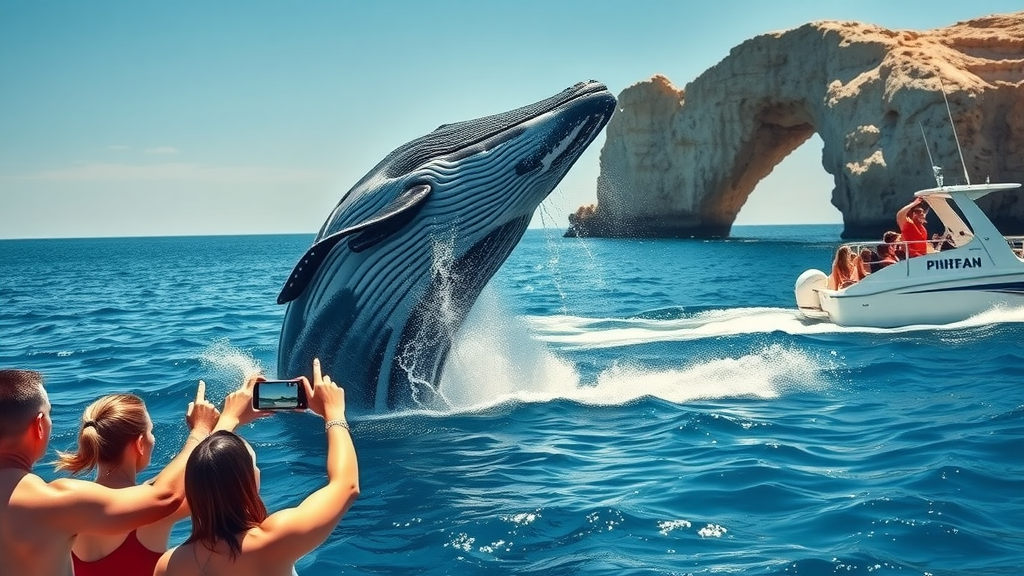
What You’ll Learn From This Cabo Whale Watching Guide
- Best times to experience whale watching in Cabo
- Top-rated whale watching tours in cabo san lucas
- Essential preparation tips for your whale watching tour
- Answers to the most common whale watching questions
This guide provides you with practical advice on every aspect of cabo whale watching—from pinpointing the peak watching season, to choosing the right tour operator, and preparing with the must-have gear. Discover how to make the most of your adventure with details on marine life, safety tips, and insider info from marine biologists and local experts. Whether you’re a first-timer or a returning visitor, this article is your ticket to truly unforgettable whale watching in Los Cabos.
If you’re planning a family adventure, whale watching is just one of many ways to create lasting memories in Cabo. For more inspiration on family-friendly activities and tips for making the most of your trip, check out these ideas for creating unforgettable family moments during your vacation in Cabo San Lucas.

The Science Behind Cabo Whale Watching: Whale Migration Explained
Every year, a spectacular whale migration unfolds off the coast of Baja California, bringing thousands of whales into Los Cabos waters. The annual journey draws species like the majestic humpback whale, incredible gray whale, and the immense blue whale. As they migrate from cold northern waters to the warmer, safer Pacific and Sea of Cortez, Cabo San Lucas becomes one of the world’s best whale watching hotspots. Marine biologists and seasoned guides reveal that this migration is vital for whale breeding and calf survival, turning each watching tour into a front-row lesson in ocean science.
The Pacific waters of Cabo San Lucas—noted for their abundance of food and ideal temperatures—provide essential resting and calving grounds for migrating whales. During the height of the whale watching season, these coastal routes are bustling with activity, drawing not only the whales but also dolphins, orcas, and other marine life, making each tour in Cabo a diverse wildlife encounter.
Whale Species You Might See in Cabo San Lucas
- Humpback whales
- Gray whales
- Blue whales
- Orcas
- Others encountered on whale watching tours
The humpback whale is known for its spectacular breaches and melodious underwater songs, making it a favorite among whale watchers in Cabo San Lucas. Gray whales, often seen with their young calves, migrate thousands of miles to reach the safety of the Baja California peninsula’s protected waters. The elusive blue whale, the largest animal on Earth, occasionally makes an appearance, thrilling those lucky enough to spot one during a whale watching tour. Orcas and other marine species add excitement to every adventure, ensuring no two tours are ever quite the same.
If you’re hoping to see a variety of whales in Cabo, keep in mind that sightings can vary each day based on weather and timing, but every tour is guided by experts committed to finding the action. With luck, you might catch humpbacks launching themselves skyward, or spot gray whales gliding alongside your boat, making your Los Cabos whale watching tour one for the books.

“Humpback whales perform some of the most athletic breaches seen in Los Cabos waters.” – Cabo Trek Captain
Why Do Whales Choose Los Cabos for Migration?
- Warm Pacific and Sea of Cortez waters
- Abundant food sources
- Safe calving locations
Los Cabos is especially attractive to migrating whales because of its warm winter waters and safe, shallow bays. The Pacific Ocean and Sea of Cortez converge here, creating nutrient-rich currents that support a thriving ecosystem, making the area a hotspot for humpback whales, gray whales, and even the remarkable blue whale. These waters are vital not only for feeding, but also for birthing and nurturing newborn calves in safety, far from predators found in colder northern regions.
The combination of abundant plankton, calm seas, and remote beaches means Cabo San Lucas offers whale mothers a peaceful environment where their young can grow strong before embarking on their return journey north. For marine biologists and ocean scientists, this makes Los Cabos one of the most important migration waypoints on Earth.
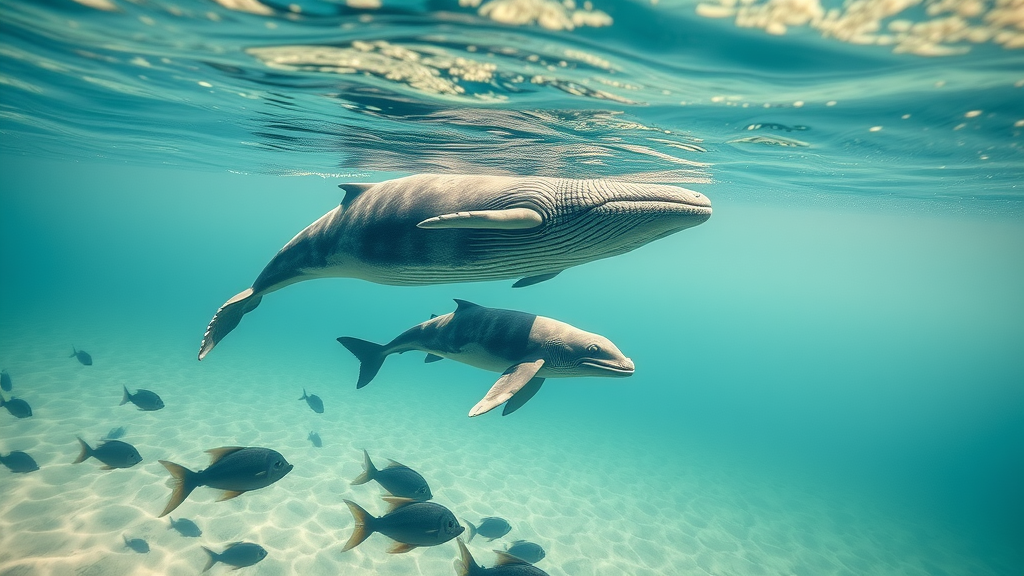
Best Time for Cabo Whale Watching: When to Visit
Timing your cabo whale watching adventure is crucial to ensuring you witness these ocean giants at their best. While whales pass through Los Cabos from December through April, each month offers unique viewing opportunities. Planning your whale watching tour around the peak months increases your chances of seeing multiple species—especially playful humpback whales and mothers with newborn calves. Guides recommend early morning tours for optimal conditions and the greatest frequency of sightings, with weather and ocean calm enhancing every experience.
The whale watching season in Cabo San Lucas aligns with the region’s mild winter weather, when clear skies, calm seas, and moderate temperatures prevail. Knowing when to go and how the seasonal rhythms affect marine activity helps ensure that your trip is both exciting and comfortable.
Whale Watching Season in Cabo San Lucas
| Month | Peak Whale Activity | Featured Species |
|---|---|---|
| December | Good | Humpback Whales, Early Gray Whales |
| January | Excellent (Peak) | Humpbacks, Grays (mothers/calves), Occasional Blue Whales |
| February | Excellent (Peak) | Humpbacks, Gray Whales, Dolphins, Orcas |
| March | High | Humpbacks, Grays, Late Season Blue Whales |
| April | Good | Humpbacks, Straggling Grays |
Most visitors agree that the best time for whale watching in cabo san lucas is from mid-January through March, when the whales are most active near the coast and prime weather conditions prevail. Pre-booking your whale watching tour during these months ensures you’ll have a front-row seat to one of the world’s greatest wildlife spectacles.

How Weather and Ocean Conditions Impact Your Whale Watching Tour
- Calm winter seas offer the best visibility
- Early morning tours for calmer conditions
- Impact of storms and wind on whale sightings
When it comes to whale watching in cabo, calm winter seas make a world of difference. Early morning is usually the best time to venture out; the wind is low, the water is glassy, and whales are often the most active on the surface. Weather in Baja California can occasionally turn windy or bring unexpected storms, which can temporarily reduce visibility and make boat travel choppy. Most reputable operators based in Cabo San Lucas monitor ocean conditions daily to provide safe and enjoyable whale watching tours.
If you’re traveling during the watching season, especially in the high months of January through March, always check with your tour operator for the latest weather updates. Dressing in warm layers for an early departure and bringing a waterproof jacket can help you stay comfortable throughout your tour in Cabo. Plan ahead, listen to the crew, and always choose an operator with a proven track record for safety.
"January through March promises the most frequent sightings—plan your trip around these months for optimal whale watching in Cabo." – Local Operator
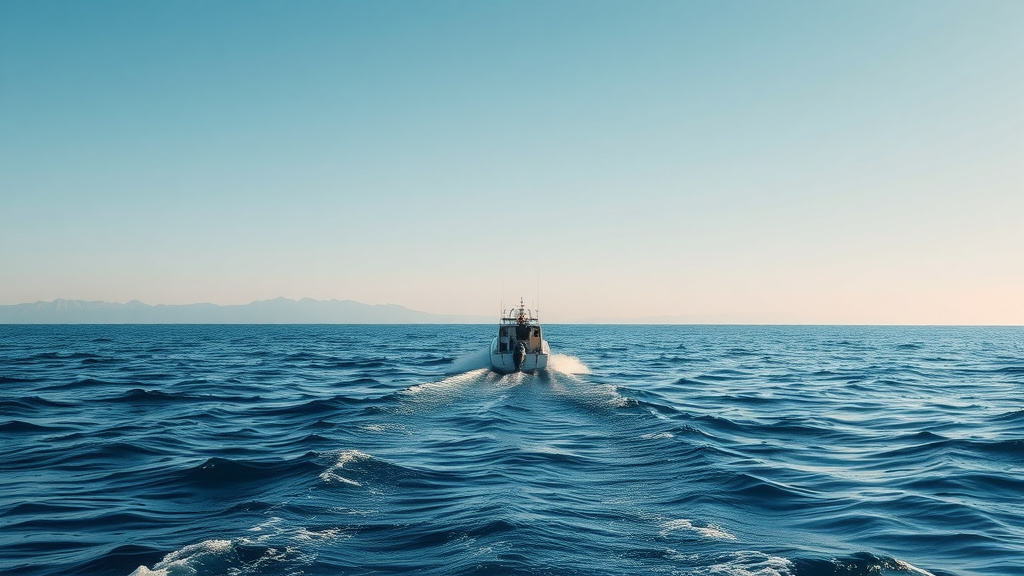
Choosing the Perfect Cabo Whale Watching Tour
With so many whale watching tours in Los Cabos, finding the right option for your group can be tricky—unless you know exactly what you’re looking for! From luxury catamarans to private adventure boats, there’s a solution for every traveler and budget. Reputable operators employ knowledgeable guides (many of them marine biologists), prioritize eco-friendly practices, and offer different experiences, such as sunrise departures or small-group adventures. Booking your whale watching tour in Cabo through established companies like Cabo Trek or Whale Watch Cabo gives you confidence in both safety and fun.
Consider your priorities: are you dreaming of a laid-back luxury cruise, a nimble zodiac ride that brings you even closer to the action, or a tailor-made private experience? Take the time to compare operators, read customer reviews, and inquire about eco-certification and safety records before you book your Los Cabos tour.
Types of Whale Watching Tours in Cabo San Lucas
- Luxury catamaran whale watching tours
- Small-group adventure boats
- Private vessels and customized tours
Each type of whale watching tour in Cabo San Lucas delivers a unique adventure. Luxury catamarans are ideal for those who love space, comfort, and onboard amenities; expect open decks, cushioned seating, and complimentary drinks. Small-group adventure boats (like rigid inflatables or pangas) offer high maneuverability and put you closer to the action—great for enthusiastic wildlife photographers or families who want an up-close experience. Private charters provide exclusivity, letting you dictate your schedule and destination for an ultra-personalized encounter.
No matter your preference, the best operators in Los Cabos guarantee a safe, informative, and unforgettable whale watching tour, making it one of the top-rated ways to explore the waterways of Baja California.

Top Whale Watching Operators in Los Cabos
- Cabo Trek
- Cabo Adventures
- Whale Watch Cabo
- Small local operators
Among the most popular choices, Cabo Trek, Cabo Adventures, and Whale Watch Cabo consistently receive high marks for their knowledgeable guides, excellent safety standards, and eco-friendly values. Small, family-run operators also offer more intimate whale watching tours, allowing you to support local businesses while enjoying passionate, personalized service. Use ratings, referrals, and detailed operator comparisons to make sure your Los Cabos adventure aligns with your travel style and expectations.
| Operator | Tour Type | Average Price | Group Size | Rating | Eco-Certified |
|---|---|---|---|---|---|
| Cabo Trek | Small Group Adventure | $89 | 8–12 | 4.9★ | Yes |
| Cabo Adventures | Luxury Catamaran | $99 | 20–40 | 4.8★ | Yes |
| Whale Watch Cabo | Family & Private Tours | $75–$130 | Flexible | 4.9★ | Yes |
| Local Operators | Custom/Private/Shared | $65–$110 | Flexible | 4.7–4.9★ | Varies |
Choosing an operator with a marine biologist or conservation focus not only enhances your experience but also helps protect the very whales you’re coming to see. Book early to secure your preferred date and make the most of your time in Cabo San Lucas or San Jose del Cabo.
What to Bring on Your Cabo Whale Watching Adventure
- Binoculars and cameras with zoom
- Hat, sunglasses, and reef-safe sunscreen
- Warm layers for early morning tours
- Motion sickness remedies for sensitive travelers
To make your Cabo whale watching adventure as comfortable as it is memorable, preparation is key! A pair of binoculars and a camera with a good zoom lens will help you capture every leap, breach, and tail slap—without missing any details. The sunlight on the water can be intense, so don’t forget a wide-brimmed hat, UV-protective sunglasses, and reef-safe sunscreen to shield yourself throughout the tour.
Early departures can be cool and breezy, even in sunny Los Cabos, so pack a light jacket or windbreaker. If you’re prone to seasickness—especially on smaller adventure boats—a motion sickness remedy like ginger candies or sea-bands can be a lifesaver. Prepare ahead, and you’ll be free to enjoy every moment, whether you’re on a luxury catamaran or a nimble panga.

Essential Tips for Enjoying Whale Watching Tours
- Arrive early to secure the best spots
- Follow crew instructions for safety and success
- Be patient—nature operates on its own schedule!
Ready to maximize your whale watch experience? Arrive at the marina at least 15–30 minutes early to check in, meet your crew, and grab a prime seat on the boat. Listen carefully to the captain’s safety briefing—these pros know the habits of whales in Cabo better than anyone. Staying attentive not only keeps you safe but can lead to unique photo ops and close encounters with marine life.
Patience pays dividends: whales don’t run on a set schedule, and sometimes the best moments happen after a few minutes of quiet searching. Embrace the unpredictability and keep your camera ready. Remember, every whale watching tour in Cabo is a chance to witness something new, so savor the adventure!
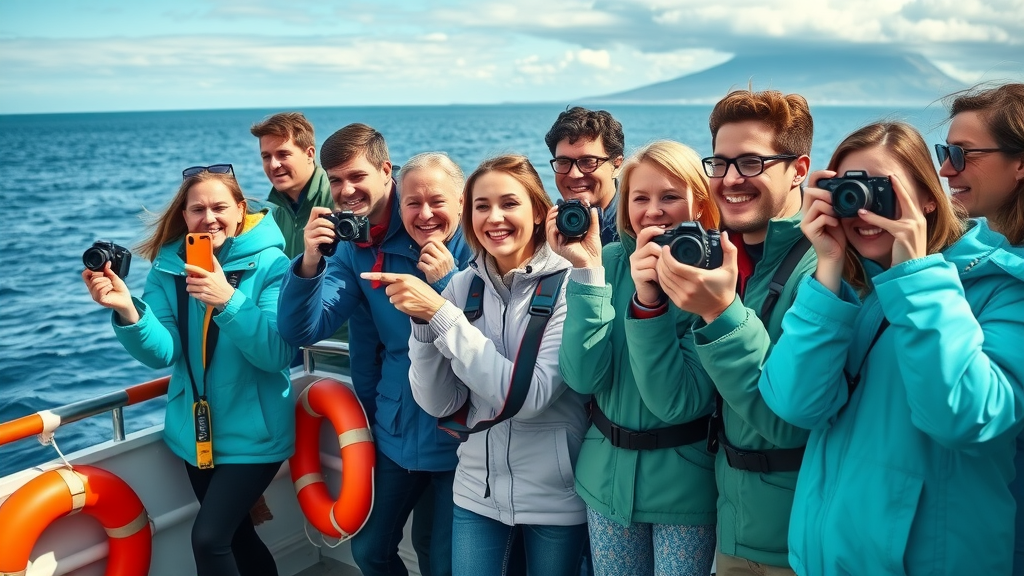
Best Places to Watch Whales in Cabo and Surrounding Areas
While boat tours offer unbeatable close-ups, did you know that the landscape around Los Cabos features top onshore whale watching vantage points? Whether you set sail on a guided tour or stay on the beach, the dramatic coastline of Baja California delivers world-class whale encounters.
From Cabo San Lucas to San Jose del Cabo, unique land-based and boat-based opportunities abound for spotting everything from humpbacks breaching to pods of dolphins at play.
Top Whale Watching Spots in Cabo San Lucas
- Land’s End (El Arco)
- Chileno Bay
- Santa Maria Bay
- Pacific-side beaches
El Arco at Land’s End is the region’s most iconic natural landmark and a favorite spot for both shore- and boat-based whale watching in Cabo. Chileno Bay and Santa Maria Bay offer calm waters, clear views, and easy beach access for families. For more secluded experiences (and fewer crowds), explore the Pacific-facing beaches west of Cabo San Lucas, where whales are often spotted close to shore, especially during peek migration.
All these locations bring you close to the action, making them popular with photographers and nature lovers eager for that perfect shot of whales in Cabo waters. Keep your binoculars handy and watch for spouts, fins, or the astonishing leap of a humpback against the blue horizon!
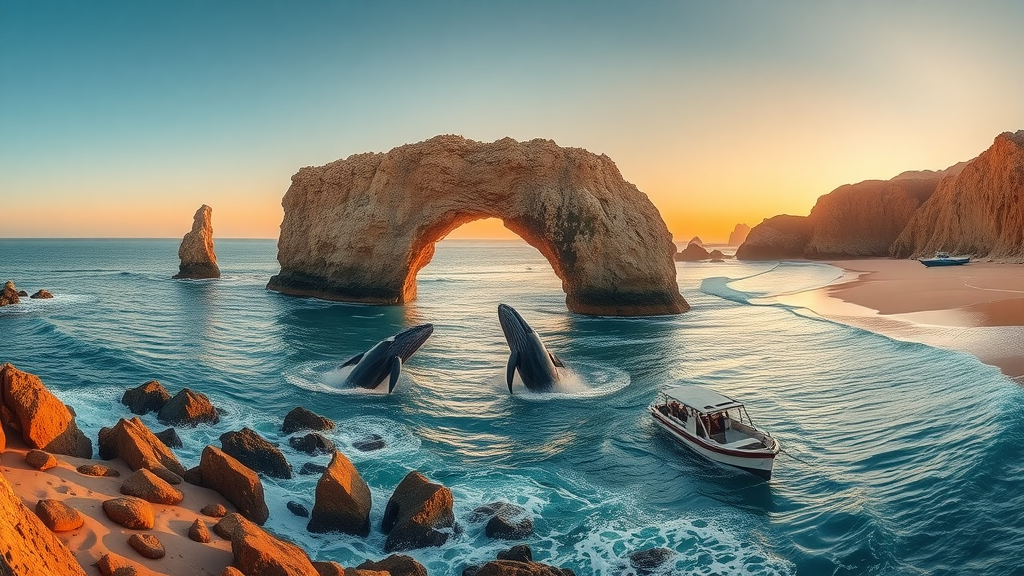
Whale Watching From Shore vs. By Boat
- Pros and cons of shore-based whale watching
- Best vantage points in San Lucas and San Jose del Cabo
Watching whales from shore can be magical—especially from the elevated cliffs west of San Lucas or along quieter beaches in San Jose del Cabo. The advantages include no risk of seasickness, ease for families with young children, and the ability to picnic or relax while wildlife spotting. The trade-off? Whale sightings from shore are less frequent than up-close encounters possible on a guided whale watching tour in Cabo.
For the best of both worlds, many visitors combine a boat tour with hikes to popular vantage points. From the clifftops near El Arco to the shoreline parks of San Jose del Cabo, the region serves up plenty of whale-spout spotting opportunities—all backed by the dramatic scenery of Baja California.

People Also Ask About Cabo Whale Watching
What is the best month to see whales in Cabo San Lucas?
Mid-January to early March is widely considered the peak of the whale watching season in Cabo San Lucas, offering the greatest variety of whale species and most reliable sightings.
Is whale watching in Cabo worth it?
Absolutely. Cabo whale watching delivers an unforgettable experience, featuring close-up encounters with majestic humpback whales, playful dolphins, and stunning coastal scenery.
Is it whale season in Cabo right now?
Whale watching season typically runs from December through April. Check with local operators for real-time updates on current sightings in Los Cabos.
Is there whale watching in Los Cabos?
Yes, Los Cabos is renowned for its premier whale watching tours, with tours departing regularly from Cabo San Lucas and San Jose del Cabo throughout the season.
Frequently Asked Questions: Cabo Whale Watching Tours
- Are Cabo whale watching tours eco-friendly?
- Can I bring children on a whale watching tour?
- How long do most tours last?
- Will I see other marine life, like dolphins or sea lions, during my tour?
Key Takeaways for Planning Your Cabo Whale Watching Tour
- The whale watching season peaks January to March in Cabo San Lucas
- Reserve tours in advance for the best selection and value
- Bring the right gear to ensure an enjoyable excursion
- Choose a reputable, eco-conscious operator for a safe, ethical adventure
Find the Cabo Attractions and Excursions That Suit Your Lifestyle and Budget
Explore top-rated whale watching tours in Cabo and curated excursions across Los Cabos. Plan your perfect adventure and make your visit unforgettable. Visit https://curatedcabo.com/excursions to book now!
Conclusion
With unparalleled marine life, stunning landscapes, and a range of operator options, cabo whale watching offers an adventure every traveler should experience. Book early, pack smart, and immerse yourself in the magic of Los Cabos!
If you’re inspired to explore even more of what Los Cabos has to offer, why not broaden your horizons beyond the waves? Discover the region’s rich history, vibrant culture, and hidden gems with a comprehensive travel guide that goes far beyond whale watching. For a deeper dive into the evolution of Cabo from its indigenous roots to its status as a world-class destination, explore the ultimate guide to Los Cabos travel and unlock new adventures for your next getaway.
Sources
For an in-depth exploration of whale watching in Cabo San Lucas, consider the following resources:
-
“Whale Watching | Cabo San Lucas | México”: This guide offers comprehensive information on whale watching tours in Cabo, emphasizing eco-friendly practices and providing insights into the best times and locations for sightings. (whalewatchcabo.com)
-
“Humpback Whale Watching in Cabo (2025 Season Guide)”: This article provides detailed information on the 2025 whale watching season in Cabo, including peak times, tour recommendations, and types of whales commonly seen. (sallysees.com)
These resources will enhance your understanding and planning of a memorable whale watching experience in Cabo San Lucas.
 Add Row
Add Row  Add
Add 




Write A Comment